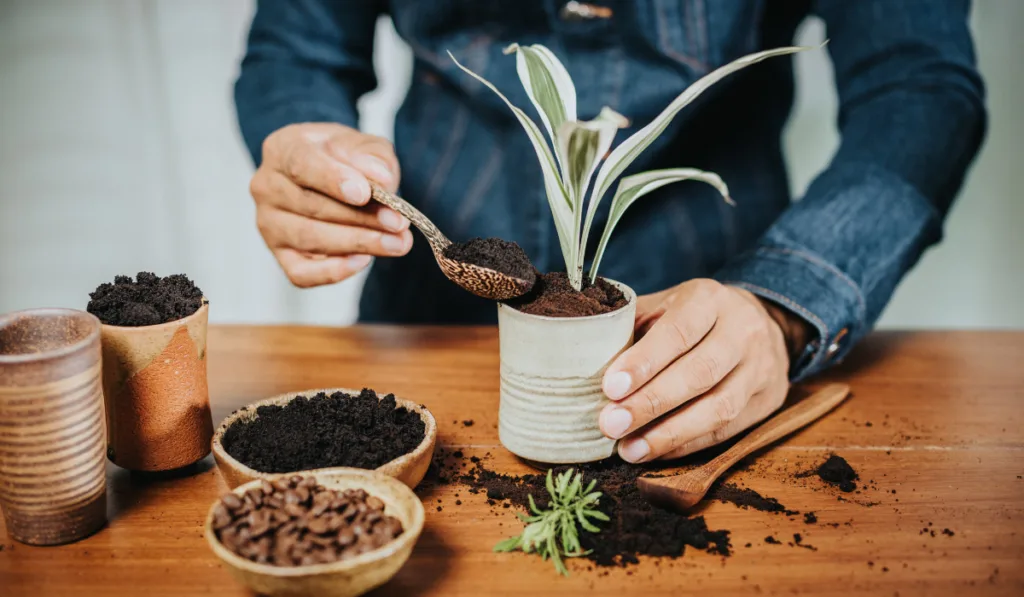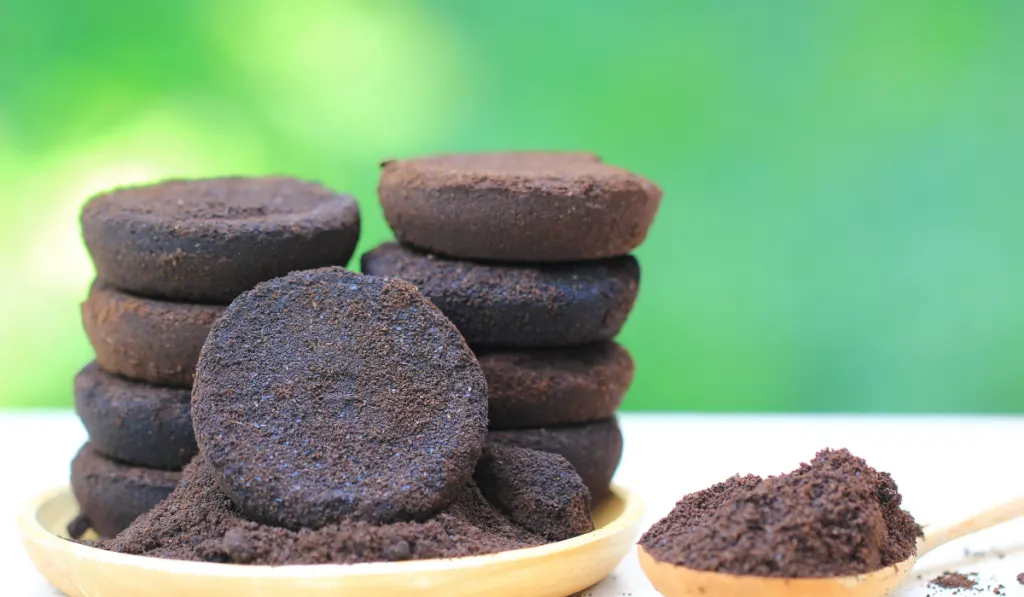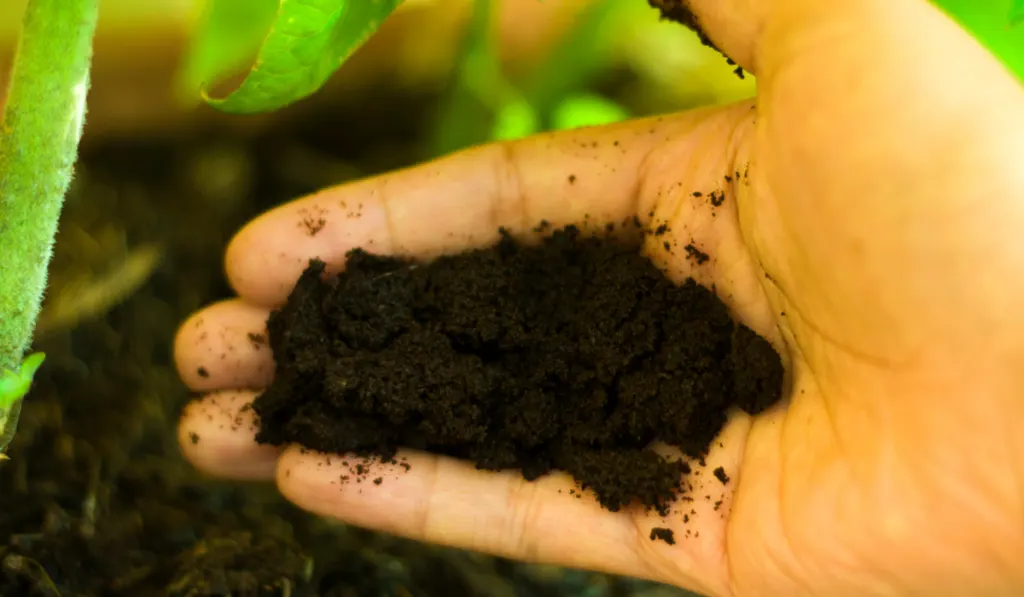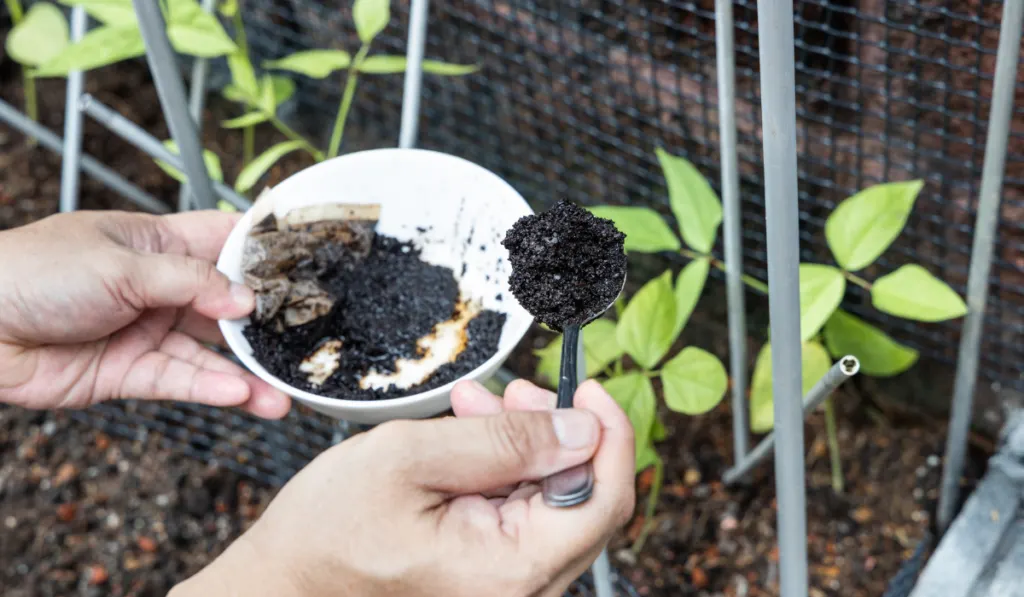They might be waste to a coffee brewer but to your garden, they might just be the Holy Grail. Next time you think about throwing out your coffee grounds, you may want to save them for your garden instead. But what benefits do coffee grounds offer to your garden?

Generally, coffee grounds are a source of minerals and nutrients like nitrogen and potassium. These minerals are very essential for the optimal development of plants.
Apart from providing nutrients to plants, coffee grounds also help remove toxins like heavy metals from the soil. Coffee grounds improve soil aeration, deter snails, slugs & insects, fight diseases, and improve the water retention of the soil.
If you are looking to learn more about the benefits of coffee grounds in your garden, then you are on the right page. We highlight 7 facts about coffee grounds, the benefits of coffee grounds, and how to use them in your garden.
Table of Contents
1. Coffee Grounds as Soil Amendment

As hinted in the introduction, coffee grounds serve many purposes in your garden. One of these purposes is to serve as a soil amendment.
You can mix coffee grounds with your soil to improve aeration. Coffee grounds attract earthworms and earthworms loosen the soil by burrowing through it. By loosening the soil, earthworms improve soil aeration.
Coffee grounds also serve as a substrate for soil microorganisms to thrive. These microorganisms are important to maintain the nutrient content of the soil.
Coffee grounds are a very good water absorbent. So, when you mix them with soil, they can improve nutrient and water retention.
2. You Can Plant Seeds in Coffee Grounds

Coffee grounds are commonly used as a source of nutrients for plants. But can you use them as potting soil or plant seeds in them?
You can plant seeds in coffee grounds and watch them grow successfully. While it is commonly thought that coffee grounds are acidic, this is not usually so.
Some coffee grounds (mostly fresh coffee grounds) can be acidic but when they are, they are usually slightly acidic. The brewing process removes most of the acid so the pH of coffee grounds is usually 6 – 7. Also, used coffee grounds or washed coffee grounds are usually neutral.
Many seeds or plants cannot survive in acidic conditions because at low pH, nutrients are not readily available for uptake by plants. This is why you have to consider the acidity of coffee grounds.
The good news is that at the usual pH of coffee grounds (pH 6 – 7), the uptake of nutrients by plants will not be affected.
A drawback that comes with using coffee grounds as a planting medium is phosphorus deficiency. Coffee grounds have low phosphorus content (1% or less) and this may not be sufficient for your plants.
You will find that the leaves of your plants will come out purple instead of green when they are not getting enough phosphorus. Also, the growth of your plants will be stunted if the phosphorus content of the coffee ground is insufficient.
But this does not rule out the use of coffee grounds. You can correct this deficiency by adding phosphate fertilizers, bone meal, or rock phosphate to the coffee grounds.
While you can plant seeds in coffee grounds, the success rate of using this medium is not as high as using soil. Coffee grounds alone may not contain sufficient quantities of the nutrients needed by your plants to thrive. So, if the right soil is available, you may want to opt for that instead.
3. Coffee Grounds Are Good for Tomatoes

The high nitrogen content of coffee grounds makes them very good for tomatoes. But this depends on how you use it.
Tomato plants prefer slightly acidic medium for growth. You may consider growing your tomato plant in coffee grounds granted such coffee grounds have a slightly acidic or neutral pH.
You may also have to supplement the nutrients contained in the coffee grounds for the best results.
Apart from using coffee grounds as a medium for planting tomatoes, you can use them for other purposes. You can use them as mulch, as fertilizer, or in making compost for tomatoes.
You can use coffee grounds as fertilizer directly on the soil in which your tomato plants are planted. Alternatively, you can convert coffee grounds to compost before using them on tomato plants. To create a coffee-ground compost combine coffee grounds with leaves and lime or wood ash.
Lime or wood ash will help balance the pH of coffee grounds. Wood ash also contains nutrients that can be beneficial to tomato plants. This mix should not contain more than 20% coffee grounds. Larger portions of coffee grounds can be detrimental to tomato plants.
4. Growing Pepper Plants in Coffee Grounds

Coffee grounds are very good for pepper plants. They can provide up to 60 days of nutrient coverage for pepper plants. If your pepper plants have stunted growth or are not healthy enough, you can use coffee grounds to rejuvenate them.
The nitrogen content of coffee grounds is particularly important to pepper plants. With sufficient nitrogen, your pepper plants will grow more leaves and produce stronger stems.
There is a caveat that comes with supplying nitrogen to pepper plants. If your plant gets too much nitrogen, you will get sufficient leaves from it but the pepper production will fall.
One advantage of improved leaf production is shade. The leaves help shade the soil from the sun and minimize temperature changes that can disturb the plants’ growth. Coffee grounds also cover the soil to minimize temperature changes in the soil.
When using coffee grounds with pepper plants, you can use them as fertilizer, mulch, or compost. When using as mulch, spread a thin layer over the soil (about 0.5 inch – 1 inch).
5. Parsley in Coffee Grounds

Vegetables enjoy coffee grounds and parsley is not the odd vegetable out. In parsley, the nitrogen content of coffee grounds promotes the growth of foliage. Most parts of parsley are foliage, so coffee grounds can contribute to increased parsley yield.
Apart from this, coffee grounds support the growth of soil microorganisms. Many of these microorganisms breakdown the soil nutrients into forms that can be absorbed by parsley. If you intend to use coffee grounds for parsley, you may use it as mulch, fertilizer, or compost.
6. Coffee Grounds as Weed Killers

Another fun fact about coffee grounds is that you can use them to prevent the growth of weed or as weed killers. Applying coffee grounds to the soil as mulch is a good way to prevent or kill weeds.
Lay the top of the soil surrounding your plants with 2 – 3 inches of coffee grounds. This will block out light and air.
With light and air blocked out, the seedlings/seeds of weeds should not grow. You may have to replenish the mulch layer regularly to ensure the thickness is maintained.
But things are not so straightforward. Insects, birds, and even wind may deposit weed seeds on the coffee ground and this can cause weeds to grow. To avoid this, you can change the coffee grounds regularly.
Another thing to note is that some plants will actually thrive when you use coffee grounds as weed killers against them. If the weed you intend to remove from your garden will thrive on coffee grounds, you should try another weeding method.
7. Caffeinated Coffee Grounds and Plant Growth

Depending on the method used in brewing coffee, coffee grounds may still contain a significant amount of caffeine. Generally, the longer the brewing process, the lower the caffeine content.
But what is the significance of caffeine from coffee grounds to plants? Although it is thought that caffeine can improve the growth of some plants, there are no demonstrable studies to back this claim.
Many such studies do not use pure caffeine. So, the observed improvement of growth may be due to other substances in the caffeine source used.
A study by Sledz et al showed that caffeine solution can inhibit seed germination and plant development. (source) This study was carried out on seeds of tomato and lettuce. This same study also showed that caffeine made potato plants shorter when compared with control.
While there seems to be no decisive study so far, it seems more likely that at certain concentrations, caffeine can distort plant growth.
Resources
- https://www.houzz.com/discussions/1997588/coffee-grounds-as-a-planting-medium
- https://www.backwoodshome.com/you-can-make-your-own-fertilizers/
- https://www.thespruce.com/using-coffee-grounds-in-your-garden-2539864#
- https://homeguides.sfgate.com/tomato-plant-care-using-coffee-grounds-38512.html#
- https://homeguides.sfgate.com/amount-ph-needed-grow-tomatoes-45120.html
- https://www.healthline.com/nutrition/uses-for-coffee-grounds#section2
- https://www.gardeningknowhow.com/edible/vegetables/vgen/vegetables-in-coffee-grounds.htm#
- https://www.gardenmyths.com/coffee-grounds-in-garden/
- https://www.finegardening.com/article/six-tips-for-effective-weed-control
- https://www.gardeningknowhow.com/garden-how-to/mulch/weed-growth-in-mulch.htm
- https://extension.colostate.edu/topic-areas/yard-garden/choosing-a-soil-amendment/#
- https://www.education.com/science-fair/article/effect-caffeine-plant-growth/#
- https://www.gardeningknowhow.com/composting/ingredients/coffee-grounds-gardening.htm#
- https://www.planetnatural.com/coffee-grounds-compost/
- https://homeguides.sfgate.com/stunted-pepper-plants-coffee-grounds-80762.html
- https://www.frontiersin.org/articles/10.3389/fpls.2017.01617/full
